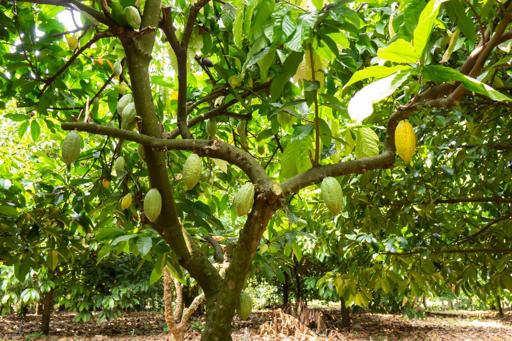Cocoa
Theobroma cacao
Also known as: Chocolate Tree

Growing Information
Growth Habit: Tree
Climate Requirements: Prefers hot and humid tropical climates with temperatures ranging from 20–30°C and rainfall distributed evenly throughout the year.
Soil Requirements: Well-drained, fertile soils with a pH of 6.0–6.5.
Water Requirements: Requires consistent moisture, with regular rainfall or irrigation.
Planting Instructions: Cocoa is typically grown from seeds or grafting. Space plants 3–4 meters apart.
Harvesting Information: Harvested once the pods ripen and turn yellow or orange, typically 5–6 months after flowering.
Characteristics & Benefits
Plant Characteristics: Cocoa is a small evergreen tree grown for its seeds (cocoa beans), which are used to produce cocoa mass, butter, and powder, essential ingredients in chocolate production.
Nutrient Content: Cocoa beans are rich in antioxidants, fiber, and minerals like magnesium, iron, and copper.
Health Benefits: Cocoa has potential health benefits such as improving heart health and cognitive function due to its flavonoids.
Yield Information: Average yield is 400–600 kg of dried cocoa beans per hectare.
Uses & Distribution
Culinary Uses: Used to produce cocoa powder, cocoa butter, and chocolate products.
Industrial Uses: Cocoa is used in chocolate production, cosmetics, and pharmaceuticals.
Native Range: Native to the Amazon Basin in South America.
Current Distribution: Cultivated in tropical regions around the world, especially in West Africa, Southeast Asia, and South America.
Pest & Disease Management
Common Pests: Cocoa pod borer, mealybugs, and aphids.
Diseases: Black pod disease, witch's broom disease, and frosty pod rot.
IPM Practices: Use of resistant varieties, proper spacing, and sanitation practices to reduce pest and disease risks.
Market Value: $1500.00
Research & References
Studies and Articles: Research on improving disease resistance and climate change adaptation in cocoa.
Bibliography: Cocoa Cultivation and Processing, 2023.
Comments
Add CommentNo comments yet. Be the first to comment!